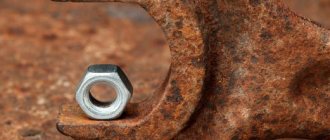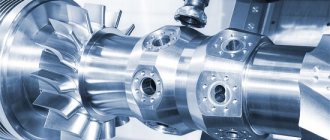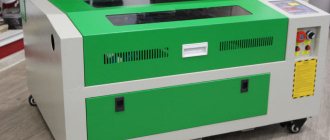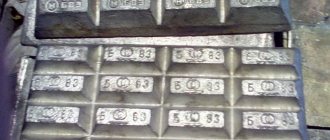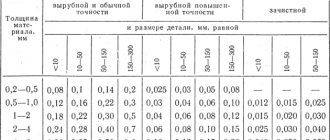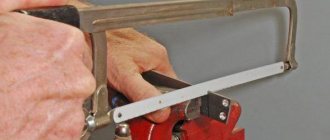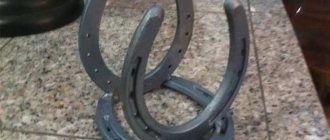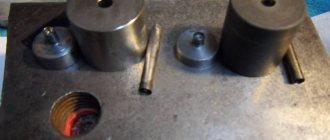Types of forgings
There are many forms of finished products. They depend on the shape of the pressing equipment used. Forgings from square billets are most often used. They are produced by stamping or machine forging.
Let's consider the existing types of forgings:
- Stainless. Made from corrosion-resistant steel. The production uses material with a homogeneous structure. The products are in demand in shipbuilding and the energy industry. Large parts such as shafts or turbines of thermal power plants are made from them, so their weight can be calculated in tons.
- Alloyed. They are made from special grades of steel that contain elements designed to improve the performance characteristics of the metal. These include chromium, manganese, nickel, silicon and cobalt. These materials can give the metal increased hardness, strength and other useful properties.
- Press forgings. Such blanks are produced by hot or cold plastic deformation of metal on presses. They are widely in demand in mechanical engineering, shipbuilding, mining and other industries.
- Hammer forgings. Obtained by metal forging. The blanks are characterized by high hardness and flexibility. They are used in the automotive industry in the manufacture of load-bearing elements and large transport components.
- Instrumental. Made from carbon or alloy steel. Excellent performance properties are in demand in the production of high-strength, high-precision tools and other industries. Differ in a variety of shapes.
- Carbonaceous. Such blanks are produced from high-strength steel grades. They are actively used in construction in the manufacture of load-bearing structures of objects. In addition, they are used in bearing production.
Forging and rolled metal should not be confused. Despite the visual similarity, the materials differ in the production method and, as a result, in the technical characteristics, even when using the same grade of steel.
Workpieces with a galvanized surface deserve special mention. The thickness of the protective layer depends on the brand of the product. Zinc is resistant to corrosion and aggressive environments. This allows you to increase the service life several times. Galvanized workpieces are in demand in difficult climatic conditions.
Despite the variety of shapes, the most popular in industry is square forging.
Forging: types, production and application
In the article we will take a closer look at such a metal product as steel forging, namely about the varieties produced, manufacturing methods and main uses in various industries.
What is forging?
A metal forging is not a complete product, but only a metal blank for the manufacture of standard rolled products or machine parts. It has different cross-sectional shapes (round, square, polygonal and non-standard options by additional agreement) and does not depend on the steel grade.
Its main difference from a steel circle, square, hexagon and other similar rolled products is the size, the steel used and the heat treatment of the materials.
Basic documents regulating production, steel grades used, as well as technical characteristics of the resulting products:
- GOST 8479-70 – for products made of structural steel,
- GOST 7829-70 – allowances and tolerances for the above metal products,
- GOST 7505-89 – for stamped forgings,
- GOST 25054-81 – for products resistant to corrosion.
As for the steels used, the raw materials are: 20X13, 07Х16Н4Б, 14Х17Н2, 08X13, 07Х16Н6, 08Х18Г8Н2Т, 04Х18Н10, 10Х14Г4Н4Т, ХН65МВ and a number of other grades.
The choice of a specific one depends solely on the further use of the finished product and the required characteristics.
The raw materials influence the type of forging obtained!
How is it made?
Due to the wide variety of steels and alloys and the different requirements for finished products, different production methods are used. They can be divided into two large groups.
Stamping
Main advantages:
- high dimensional accuracy of the resulting part,
- smoothness and uniformity of the surface,
- high release speed due to the simultaneous formation of several surfaces at once,
- reduction of time and money costs.
Also, a similar method can be divided into 2 more:
- cold stamping,
- hot.
During stamping, the raw material is pressed with a special stamp, which distributes the metal of the workpiece according to the mold. Due to the equipment used and the process itself, the resulting metal products are also often called stampings.
Forging
Forging is the second manufacturing method. Its main difference is that the required product is gradually produced from the workpiece. Depending on the weight and size of the workpiece, the molding of the product is carried out using various mechanized hydraulic presses or manually - with sledgehammers and hammers.
Where is it used?
As we said earlier, these products can be used in many areas.
A few examples:
- In metallurgy – rolls, supports and stands, blanks for stamping and rolled pipes. This industry is the main one in terms of consumption.
- In the oil industry - for the production of shells and pipes.
- In the electric power industry - as blanks for rotors, generator shafts, and turbines.
- In mining - for the production of rolls, axles and gears.
- In shipbuilding - for propeller shafts.
- In construction - for the manufacture of brackets, clamps, anchors and other fasteners.
What types of forgings are there?
Based on the raw materials used, the following varieties can be distinguished:
- Carbon forgings . The raw materials for production are high-strength carbon steels. Such forgings are used to create elements of critical structures and mechanisms of increased reliability.
- Stainless . As you might guess, they are made from stainless steel. The main application is work in unfavorable conditions, for example, high humidity.
- Alloyed . They are made from special steels enriched with alloying elements, thanks to which the material receives additional properties: increased hardness, corrosion resistance and others.
- Instrumental . The raw materials are special steels, which makes it possible to obtain high-precision, durable products that allow processing of various materials. For example, this includes cutters for working with wood and metal.
You can also divide by production method. Accordingly, metal forgings can be :
- Press . Produced by stamping. They vary in characteristics and areas of application.
- Molotovs . Produced using forging hammers. They have good flexibility.
of Forgings in Chelyabinsk and the Chelyabinsk region
. We operate in many areas and cooperate with many well-known companies that highly value our reliability and quality of service. Various promotions and discounts are available for regular customers.
Receipt methods
Manufacturing forgings is a rather complex technological process. There are two methods for obtaining blanks:
- Forging. This method of producing forgings is characterized by preheating the metal to a plastic state. After this, the workpiece is given the desired shape using the impact load of a hammer or press. A feature of the process is the free position of the workpiece during processing. Forgings produced by forging are distinguished by high machining allowances. This figure is almost 2 times higher than that for stamped products. Bending, drawing and drawing are also types of forging.
- Stamping. The main role in the production process is played by special equipment called a die. The matrix exerts high pressure on the workpiece. Its shape completely follows the contours of the finished product. The function of the power element is performed by the punch. The production process can take place in both cold and hot modes. The method is highly productive. No highly qualified workers are needed to service the equipment. Compared to forging, the finished product has more accurate dimensions and less surface roughness. The only disadvantage of stamping is the high cost of the equipment. It is advisable to use it only in mass production.
What is forging? Stages of the forging manufacturing process
Today, metal forming is the most common and technically sound method of producing blanks, called forgings, which are subsequently machined to achieve the required dimensions and configuration of the part.
The forging manufacturing process goes through the following stages:
1. Cutting rolled products of various configurations into the required sizes.
The rolled products used can have round, square, rectangular and polygonal sections. Sometimes it is allowed to use a workpiece in the form of a special profile (angle, I-beam, channel)
2. The process of metal deformation.
3. Heat treatment of forgings (normalization and tempering)
4. Reception of the finished forging by the technical control department.
Methods used to make forgings
Today there are two main methods for obtaining forgings:
• Forging is the process of deforming a metal workpiece, which is in a plastic state, and giving it the desired shape by exposure to the impact load of the hammer or press strikers. Forging also includes bending, drawing, and drawing. A distinctive feature of forging is that the workpiece is in a free position during the deformation process; it does not have a clear location.
The allowance for processing a forged forging is almost 2 times greater than for a forging obtained by stamping. In production, forging is used only in small-scale and single-piece production, using two main methods: manual or machine.
• Stamping is the process of deforming the original metal workpiece under pressure, which occurs using additional equipment (special stamp).
The process of plastic deformation is carried out in the die matrix, the shape of which is completely identical to the manufactured forging. The impact element that exerts the load is the punch.
Stamping can be performed with or without preheating the original workpiece.
Stamping, in contrast to forging, has a fairly high productivity, it does not require highly qualified workers, and the resulting forging has higher dimensional accuracy and low surface layer roughness. However, the use of stamps is only advisable in mass and serial production in order to justify the costs of their expensive production.
Alloy steel grade 5ХНМ (tool die) is widely used in industries where high demands are placed on manufactured products in terms of hardness, strength, wear resistance, and where high manufacturing precision is required. Often this is tool production and machine tool manufacturing.
Forgings produced from 5ХНМ steel have found their main application in the design and production of press dies, forging units, and hammers.
Steel 5ХНМ has the following mechanical properties:
Tensile strength B - 1570 MPa Yield strength T - 1420 MPa Hardness after annealing - 241 MPa
Impact strength KCU – 340 kJ/m2
Analyzing the physical properties and composition of the basic alloying elements of 5KhNM steel, it can be noted that due to the high content of chromium - up to 0.8% and nickel up to 1.8%, the steel has high hardness, strength and elasticity, which helps to avoid cracks on the surface of the forging after its thermal treatment processing. The molybdenum content of up to 0.3% contributes to good impact strength, thereby preventing the steel from becoming brittle after tempering.
Forgings made of die steel 5ХНМ are subjected to annealing, preparing them for subsequent heat treatment and ensuring the removal of internal stresses in the structure.
In order for a tool made from die alloy steel 5ХНМ to have maximum hardness and have a long service life, finishing heat treatment is required. Hardening is carried out at a temperature that reaches 850°C, and then subsequent tempering is carried out at a temperature of 460-520°C.
The environment in which quenching and tempering will be carried out, as well as the temperature regime, is selected by the technologist depending on the operating conditions and the shock load of the tool being manufactured. However, it must be remembered that high temperatures during the hardening process can cause an increase in the hardenability of steel and, as a result, a decrease in impact strength.
There are also foreign analogues of die alloy steel 5ХНМ, which has also gained great popularity in the USA and European Union countries.
Here it is labeled in accordance with its standards in force in the country. For example, T61206 or L6 in the USA and 55NiCrMoV7 in the European Union.
Source: https://partalstalina.ru/article/item/27
Forging manufacturing process
Regardless of the method of obtaining the finished product, the production of forgings consists of the following stages:
- Cutting rolled metal into pieces of the required size. The standard size and cross-section of the feedstock depends on the capabilities of the suppliers. It can be a circle, square, polyhedron, and even a channel or I-beam.
- Metal deformation. During forging, the workpiece is ground under the action of repeated blows. Stamping is characterized by uniform pressure on the forging, resulting in the formation of a finished surface.
- Normalization and tempering of the workpiece.
- The quality of the finished product is determined by technical control specialists.
Manufacturing of forgings and stampings: technology features
Forging and hot stamping is one of the three main areas of pressure processing of piece workpieces made of metals and alloys.
Due to the fact that the ability of a metal to deform significantly increases with increasing temperature, using hot pressure treatment methods it is possible to produce products of arbitrarily complex shapes, even from steels with relatively low ductility (for example, high-alloy steels). Moreover, some alloys are pressed exclusively when hot.
The production of forgings and stampings by hot deformation is determined by the temperature at which the deformed metal ceases to be hardened. Hardening manifests itself as constantly increasing values of the plastic limit.
As a result, more and more force has to be applied to the metal, which negatively affects the energy consumption of deforming machines. During hot pressure treatment, the mobility of the grains of the macrostructure increases, and their movement becomes easier.
Therefore, the specific forces are noticeably reduced, so it becomes possible to shape steel with high degrees of deformation without fear of destruction of the workpiece.
Forging and stamping are the main types of hot forming. Accordingly, the production equipment in the first case is called forging, and in the second - forging and stamping.
The uncontrollability of thermal expansion of metal during hot forming in most cases does not make it possible to manufacture products without tolerances and allowances. Therefore, forgings and stampings are blanks that are then subject to mechanical modification along the contour, drilling holes, making grooves or fillet grooves.
Thus, by forging and stamping we understand the technology of hot metal forming, which is carried out at temperatures at the end of the austenitic transformation. For low-carbon and unalloyed steels this is a temperature range of 1050...12000C, and for high-carbon and alloyed steels - 850...9500C.
Metal forging
During forging, the flow of metal under the action of a deforming tool is not limited in any way, since the shape change occurs by pressing smooth strikers on the surface of the workpiece.
In this case, the deformation force is the smallest, however, the possibilities for precise deformation of the metal are minimal: plastic flow always occurs in the direction of least resistance, i.e., into the gap between the strikers.
Therefore, forging is a purely procurement operation and is performed in the following cases:
- For preliminary redistribution of metal in an ingot or in a rolled piece;
- For crushing the grains of the workpiece after its heat treatment.
Basic forging operations:
- Upsetting (reduction in the height of the workpiece with a corresponding increase in its diameter).
- Broaching (increasing the length of the workpiece while decreasing its height).
- Firmware closed and open - obtaining blind or through holes.
- Torsion is a helical change in the longitudinal axis of the workpiece.
- Chopping – dividing a workpiece into several parts.
Forging is carried out on steam-air forging hammers, and steam-hydraulic forging presses are used to deform especially large forgings (for example, crankshafts). A workpiece that has undergone forging transitions is called a forging.
Hot stamping
During hot stamping (by the way, it can be either volumetric or sheet: the latter is used for hard-to-deform steels, which are supplied as thick sheets with a thickness of more than 15...20 mm), the flow of metal under the action of working force is limited by the shape of the cavity of the working tool - the die. Sometimes the finished product after such a change in shape is called “stamping,” but the term “forging” is practically more common, since it is already known from the beginning whether the metal is processed by forging or stamping.
The stamp is a complex tool consisting of two halves - movable and stationary. In this case, the movable part of the stamp is attached to the press slide or to the head of a steam-air stamping hammer, and the stationary part is placed on the table of hot stamping equipment.
The presence of side walls of the die increases the deformation force due to the appearance of friction forces. However, finished stampings have significantly higher dimensional accuracy, so the tolerances are much tighter.
In addition, the availability of modern hot stamping equipment - hot stamping machines, screw and crank presses - also allows us to minimize machining allowances.
In some cases, stamped forgings only need to be descaled.
Thus, forging, stamping - the differences between them lie in the degree of accuracy of the final product and in its shape.
Sequence of hot stamping technological processes:
- Heating of the workpiece using flame or electric furnaces.
- The actual deformation (the main patterns of metal flow are upsetting and extrusion).
- Trimming flash - a technological residue, the presence of which ensures the filling of difficult-to-fill die cavities.
- Editing-calibration, as a result of which the longitudinal axis of the product, bent by thermal stresses arising during deformation, is aligned.
So, forging, stamping - the difference between them is that after deformation, forging is always subject to subsequent processing, while stamping already has a shape approaching the shape of the final part.
Application benefits
The production of the products in question is carried out by foundries. They are supplied with forging blanks, where they undergo a full technological cycle, including heat treatment. The finished product has the following advantages:
- excellent performance characteristics;
- stable mechanical properties;
- high Brinell resistance;
- low cost.
The workpiece does not require special storage conditions. If necessary, they can even be stored on an open construction site. They retain their properties for a long time.
The surface of the product is of high quality. There are no cavities, burrs, sagging or other defects on the workpieces. In addition, during metal processing there is no decarbonization of the material.
GOST 7509-89
This interstate standard determines the amount of tolerances, allowances and forging allowances for steel forgings manufactured by hot die forging. There are restrictions on weight and size. The standard states that for workpieces weighing more than 250 kg and dimensions more than 2500 mm, permissible deviations, radii of rounding of external corners and other parameters are established through negotiations between the manufacturer and the customer.
Forgings are a product in demand in various industries. They are obtained by forging and stamping the workpiece. Do you think casting parts can compete in quality with forgings? Write your opinion in the comments block.
